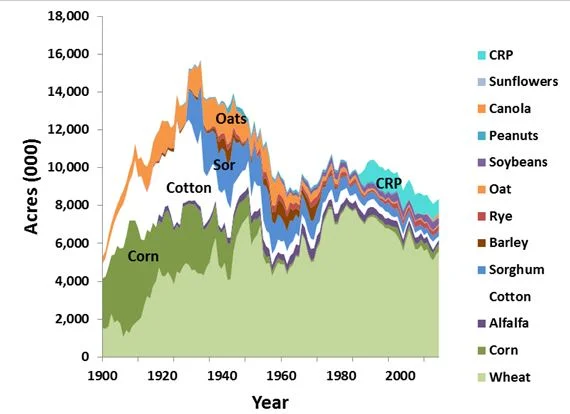I received several comments from folks about my post yesterday on the dust bowl - mostly with family stories about that time. It is almost unfathomable what some of our grandparents went through. How very lucky we are to live in today's day and age!
My colleague, Francis Epplin, followed up with a few additional insights that are worth sharing. First, if you look at acres planted to all crops in Oklahoma (not just wheat in Cimarron County, which I showed in the previous post), it becomes clear that the early 1930s really was an extraordinary time in terms of land in production.
Oklahoma acres planted to crops, 1900-2012, USDA-NASS
Francis also elaborated on changes in production practices and weed management. He graciously agreed to let me share his thoughts:
Prior to WW II (and the development of chemical herbicides), crop production required tillage to prepare a seedbed and to manage weeds. Tillage occurred prior to planting in an attempt to control competition for water and other nutrients. For summer crops such as cotton and corn, tillage occurred during the growing season. This wasn’t done for enjoyment. These production practices were brought to the Midwest from Europe and to the Western Plains from Europe and the Midwest.
A chart of OK crop acres from 1900 to 2012 [is above]. A lot more OK land was cropped (exposed to wind erosion) in 1930 than in 1900. And, a lot more was exposed to erosion in 1935 than currently. The corn and oats acres (in the early 1900s) were used to produce biofuel – feed for the horses.
Based on this chart, one of the culprits was probably cotton. Cotton doesn't produce much residue. The change in cotton acres prior to the dust bowl was to some extent price induced. Nominal cotton prices increased from $0.074/lb in 1914 to $0.354/lb in 1919. Wars mattered. By 1931 it was less than $0.06/lb. (Of course, I cherry picked the years, but farmers did respond to incentives.) This level of commodity price variability predated public policy involvement in commodity prices.
In the more arid regions wheat, also played a role because of the wheat-fallow system- one crop every two years. After wheat was harvested in June the fields were tilled in an attempt to capture moisture for the next wheat crop which was planted 17 months later. During these 17 months of fallow, tillage was conducted in an attempt to prevent weeds from becoming established and stealing moisture. During this period the soil was extremely vulnerable to wind and water erosion. Note that the chart does not include these fallow acres. We don’t have records as to how many acres were in fallow by year. In the late 20s early 30s, it could have been a million acres.
As to why not a repeat of the dust bowl in 2011-2012?
1. In OK, many fewer acres are in crop production than was the case in 1930. Millions of acres have been returned to grass (and/er Eastern red cedar). Land owners discovered that a few $/ac from pasture was better than negative income from trying to grow crops on fragile land.
2. We don’t have records, but few continue to practice the wheat-fallow system. And, if they do, they don't till it, they would use chemical herbicides.
3. Chemical herbicides have reduced the need for preplant and in-season tillage, enabling much more surface residue throughout the year.
